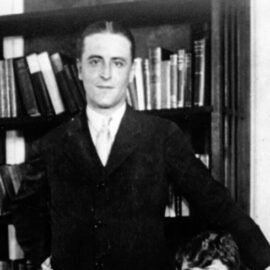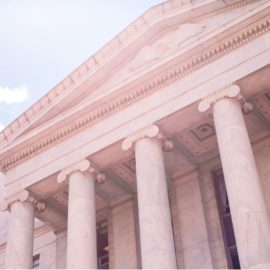

This article is an excerpt from the Shortform summary of "The Smartest Guys in the Room" by Bethany McLean and Peter Elkind. Shortform has the world's best summaries of books you should be reading.
Like this article? Sign up for a free trial here .
What is Enron’s history? How did Enron go from a huge international compamny to a failure?
Enron’s history starts off promiosing, but a combination of many factors caused Enron to collapse. Enron’s history, and tthe failrure that coincides, marks one of the biggest bakruptcy scandals in history.
Enron History: Beginning and Promise
The Smartest Guys in the Room chronicles the history of Enron, from beginning to end. Putatively, it began with good intentions and a believable vision. Then, as it focused on short-term stock prices, it became corrupted by deceptive accounting, making more egregious bets.
Ken Lay Sees an Opportunity
Ken Lay, founder and CEO of Enron, believed in efficient markets. The 1970s energy crisis caused natural gas to become deregulated. Lay saw an opportunity to profit from this deregulation.
Lay had served in various roles in gas companies before heading Houston Natural Gas (HNG) in 1984. His vision was to control a large fraction of pipeline which would allow better negotiating leverage.
Larger Omaha company InterNorth, in danger of being taken over by corporate raiders, wanted to defensively increase its size and debt load. It acquired HNG in 1985, with terms very favorable for HNG. Ultimately, Lay gained control of the board and became CEO of the company, renaming it Enron.
Things didn’t immediately work out quite as well as Lay hoped. A glut of gas on the market depressed prices and put Enron’s long-term gas contracts underwater. Management of the combined entity was tough, riddled with politics. As a public company, Enron was desperate for real earnings. It turns out for all his enthusiasm, Lay didn’t personally have strategic insights into how to create a new business model in this new deregulated world. The history of Enron shows this failure.
Enron Builds a Futures Market
In this strategic vacuum, a consultant had an answer.
In 1987, Jeff Skilling, a McKinsey consultant who worked with Enron, envisioned Enron building a futures market, turning natural gas into a commodity (then a novel concept).
Put simplistically, Enron would be the mediator between gas producers and gas buyers, with Enron earning the spread.
In Enron history. the company was able to loan gas producers more money than banks, because it knew the clearing price of the gas. So producers signed contracts to supply gas to Enron, in exchange for upfront money to develop reserves. Enron could then trade the future contracts, just like oil futures.
Enron’s physical assets, ability to actually deliver gas, and its history and reputation gave it an edge over Wall St competitors who later entered the industry.
Securitization of gas lifted capital and balance sheets as constraints on growth. Selling its loans allowed Enron to eliminate debt from balance sheets and get cash to grow further.
This later became Enron Capital and Trade Resources (ECT) and by 1996 it made $280 million in EBIT, more than 20% of Enron’s earnings.
Enron International
The Enron International arm began in Teesside in the UK, with a natural gas cogeneration plant built in 1991. This plan supplied both electricity and heat to the local area. This was a successful project, prompting energy companies to ravenously seek similar deals in developing economies.
Rebecca Mark headed Enron International. Fueled by a compensation scheme that rewarded closing deals and not actually building the businesses, Rebecca Mark globetrotted and closed deals in dozens of countries. She positioned Enron as the “solver of the unsolvable problem.” She was hungry to come up with projects bigger and better than Teesside.
The projects were often troubled. The largest scandal was in Dabhol, India. A province struck a deal very favorable to Enron, guaranteeing a long-term purchase of highly priced energy. The Indian population revolted, seeing it as rapacious globalization. This stymied development for years.
Furthermore, the financing for projects was often unclear. In Enron history, Enron International hoped the funding they would come from non-Enron sources, but sometimes Enron ended up guaranteeing the debt.
Enron International fed Ken Lay’s desire to hobnob with international luminaries like Kissinger and heads of state, making it less likely to be scrutinized.
By 1996, Enron International accounted for 15% of Enron’s earnings. This development was an important part of the history of Enron.
The Start of Bad Practices
Trading companies are too volatile to reliably produce increasing earnings. So rather than claiming to be a speculation company, Skilling branded Enron as a logistics company, finding the most cost-effective way to delivery power from any plant to any customer. This provided cover for incomprehensible businesses.
Skilling feared that any appearance of losses would shatter the illusion of Enron being wizard risk managers, so fought hard to hide them.
Skilling’s obsession with Enron’s stock price and with meeting quarterly Wall Street targets got Enron addicted to bad business practices. Enron history has the following bad practices:
- Skilling would ask analysts, “what earnings do you need to keep our stock price up?” This was the number he targeted, regardless of whether it was conceivably achievable by the company.
- Quarters would end with execs scrambling to fill “holes” in the company’s earnings and cover up losses. Deals scheduled to close on later timelines were accelerated, at the expense of costly long-term concessions for Enron.
- Enron used mark-to-market accounting for its deals, which allowed booking the total value of a deal immediately, rather than spaced out over time. They practiced this throughout the business, including on private equity and venture capital investments.
- Mark-to-market requires assumptions about the future performance of deals, and naturally they skewed optimistic. These assumptions were not visible to the public.
- Earnings projections were re-examined and made more optimistic.
- Even if deals failed or were dead, they delayed recognition of those losses in a particular quarter by pretending they were still alive.
In effect, all these dealings created fictitious cash flow and profits when they were really dealings with itself – and at some point the house had to collapse.
Two Big (Failed) Bets in Enron History
All the financial machinations around SPEs were meant as temporary measures while Enron bet big on its next two major businesses. Both of them, however, sustained massive losses. Enron’s company history has two major business that failed this way:
Enron Energy Services – Retail Utilities
Enron’s historical bread and butter was large wholesale contracts with commercial buyers. But it believed there was a coming wave of deregulation, where federal/state governments would release municipalities from local monopolies to allow the free market to drive prices down. Enron could then sell directly to businesses and homes.
In the end, few consumers really signed up for Enron’s services – 50k in California (1% of the market) and 300 in New Hampshire.
After the residential failure, Enron targeted businesses. This was enticing – a big company spends millions a year for light, heating, and cooling. Couldn’t Enron get a share of this?
The commodity part of this business was actually a money-loser – Enron’s hope was that it would make money on contracts to reduce energy costs and increase efficiency.
In Enron company history, Enron tried to argue that efficiency improvements would help them make the deals profitable, but soon it became clear those efficiency improvements wouldn’t pay for themselves.
Enron Broadband
In 1999, Internet stocks were overheated. Put “broadband” in your company somewhere, and the stock price would rise without tying to fundamentals.
- Skilling calculated that every $1 invested in broadband would pay back $20 in market capitalization.
Skilling promised such large returns that the division was strongly pressured to make deals happen. They burnt a lot of money ($500MM a year) trying to find a valuable business plan.
The larger vision was that broadband might ultimately become a tradable commodity, like natural gas or oil. But this vision failed to meet reality:
- Physical technicalities got in the way. Internet lines were set up so sharing bandwidth wasn’t possible. In one sense, internet pipes were parallel pipes that never intersected.
- Enron promised that it was inventing new routing technology that would enable bandwidth sharing, but this never made it out of the lab.
- Meanwhile, the incumbent telephone companies were uninterested in hooking into Enron’s market. This would turn bandwidth into a commodity that would cut into their control of markets.
Enron even began partnering with Blockbuster to build content streaming services. Its rosy projections made napkin-calculations on how many cities they would enter, the market share they’d have, and the # of movies users would buy. In classic Enron fashion, it booked $110 million in profits from this deal immediately, before anything had materialized.
Unfortunately, both Enron Energy Services and Enron Broadband bets were off the mark. Enron spent billions on unprofitable projects. This put Enron in an impossible position – having spent all that money and raised expectations, there was no room for failure. They could only hide the massive losses through more machinations.
Concerns Mount
There started to be mounting external and internal concern about the reality of the losses. Here is the part of Enron history where the company began to collapse.
In March 2001, this book’s author (Bethany McLean) published a landmark article, “Is Enron Overpriced”, which showed the public that professional analysts had no idea how Enron made money.
In May 2001, a researcher wrote a paper deconstructing Enron’s cash flow. Of Enron’s reported $4.8 billion in operating cash flow, $2 billion was from customer deposits (which would be paid back if energy prices fell); $1 billion was from a onetime sale of inventory, and another $1.5 billion was the result of prepay. This showed a dramatically different story than the idea that Enron’s cash flow was stable and recurring.
In July 2001, internal concern over LJM’s dealings with Enron prompted Fastow to sell his interest in the LJM funds to Michael Kopper, who left Enron to take over.
Even employees started questioning Skilling publicly: “You say we’re going to make half a billion a year. What’s your strategy?” Skilling replied: “that’s what you guys are for.”
The Dominoes Start to Fall
As a result, Enron’s stock price fell dramatically: from a height of $82 after their investor conference in Jan 2001, down to $68.50 in Feb 28 and $55 in March 21.
- Even in July 2001, when Skilling announced Enron had beaten earnings per share, share prices didn’t budge. The market had become too skeptical.
In August 2001, Skilling resigned as CEO.
- Reasons: The pressures of maintaining a rosy public facade while dealing with internal turmoil ate at him. For someone obsessed with the stock price, its decline represented a personal failure. He hated getting his hands dirty, and his job was now about fixing problems.
- Skilling’s resignation fueled suspicion that something was wrong inside Enron.
Ken Lay returned to a hero’s welcome, like the company’s savior. But having been a non-operator for years, he wasn’t helpful.
- He announced a onetime options grant of 5% of salary. The stock was at the bottom of the cycle, and “we want you to enjoy the ride back up.” The stock was at $38.
- He announced Greg Whalley, head of wholesale trading, as COO. Whalley quickly dug in and pressed for clear financials.
- Tidbit: Ken Lay himself was paying off creditors. Despite having a net worth at its peak in the 9 digits, he had “diversified” by taking out loans with Enron stock as collateral, and with terms to face margin calls at lower Enron stock prices. The loans were then put into ill-fated investments.
Here was the nightmare dominoes scenario – where all the intricately connected layers would fail because of their dependencies:
- If Enron missed earnings, its stock price would fall.
- If its stock fell, its SPE deals would unwind (since they were predicated on Enron stock prices rising), causing Enron to have to book massive debt on its balance sheet or issue new shares. This would cause further stock price falls.
- This increased debt would cause a downgrade of Enron’s creditworthiness.
- This would trigger provisions in Enron’s debt agreements to pay back loans early, and trading partners to demand cash collateral.
- Since Enron didn’t actually have cash, its ability to pay would progressively worsen, causing it to go bankrupt.
- Senior managers predicted the likelihood of this at less than 25%.
Enron’s Final Moments
The nightmare scenario is more or less what happened at the end of 2001. Over a series of months, Enron collapsed, one step after another.
On Wednesday November 28, the rating agencies cut Enron into junk territory.
- This triggered $3.9 billion in debt.
- Dynegy officially canceled the deal.
- Enron Online shut down. Shares dropped to $0.61
Banks moved to minimize their losses, asking for return of collateral. Enron didn’t have it.
On Sunday, December 2, Enron filed for bankruptcy.
Enron’s history is filled with bad decisions and poor business practices. IN Enron company history, part of the issue is that no one took a stand, assuming others were doing their part to stop bad practices. Enron history offered many valuable lessons, some of which financial advisers took.

———End of Preview———
Like what you just read? Read the rest of the world's best summary of Bethany McLean and Peter Elkind's "The Smartest Guys in the Room" at Shortform .
Here's what you'll find in our full The Smartest Guys in the Room summary :
- How Enron rose to become one of the world's most promising companies
- How Enron management's greed led it to start cutting corners
- The critical failures that crashed Enron's house of cards to the ground






